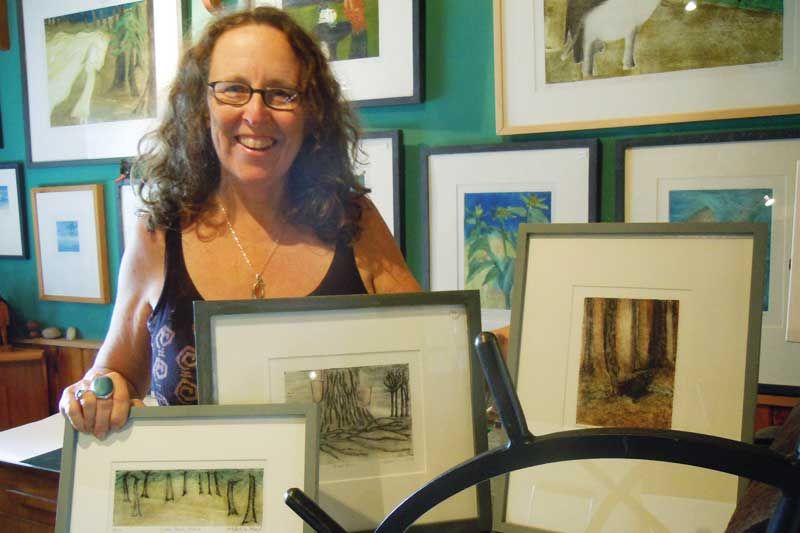Julie Druker | Sep 18, 2013
There is nothing more inspiring than gaining access to the studio of a master artist and seeing first hand great art in the place where it is created. That was the case for those who visited studio #10 on the Inroads Studio Tour, the home and studio of Martina Field.
Field is one of the original members of the 21-year-old studio tour, which took place on Labour Day weekend in and around Central Frontenac.
She has been printmaking for almost as long as she has been walking. As the daughter of two artist parents, Saul Field and Jean Townsend, both print makers, Martina recalled making her first print when she was just three years old. “My parents used to give me a little corner in their studio and they put me to work on my own stuff to keep me out of their hair. I made my first plate when I was three years old and printed it when I was four.” That first print, called “Mommy and Daddy”, shows her dad sporting his goatee and her mom with her long braid pointed vertically straight up in the frame.
As a young print maker Field entered and won numerous art contests and was included in feature articles in various publications, including the Globe Magazine. Some of her first works were also included in the Home exhibit at Montreal’s' Expo 67. At 12 years old she began assisting her parents in their studio and she recalled her dad paying her $1 for every “good” print she pulled for him. Later she became her parents' master printer and she pulled many of their print editions.
In 1963 her parents invented and developed a non-toxic method of print making that involved a substance they named compotina, an acrylic and gesso-based composition. Field uses the technique in her own print making and it allows her to both add to and take away from the print plate, offering a multi-textured print.
On display in her studio, located in her 100-year-old farmhouse, are numerous framed prints demonstrating subject matter that is based on both literary and mythological themes, often producing a series of prints that explore aspects of one theme In one series, “Zodiac”, she studied and researched myths related to the zodiac system. In another, called “In the Garden”, he husband Jeff Green wrote poems about the garden season as seen through a child's eyes. In one print from that series the text reads “Sunflower Sunflower show us your face, before summer ends and fall takes its place” and the image depicts their daughters' airy faces peeking out from behind dark green sunflower stalks that stand in an opaque and azure blue sky upon a willowy, wheat yellow dry late summer grass. These prints often have a light and airy feel with multiple textured surfaces that somehow resemble impasto, plaster or pitted rock-like surfaces with mixtures of both opaque and transparent layers of colour. They recall the works of painters like Marc Chagall in the whimsical and child-like innocence of the imagery and composition.
At the other end of the spectrum prints like “Heron” and others from the Zodiac series offer up heavier, more strongly defined images printed in more opaque colors.
Martina Field's most recent prints, such as “First Run”, which shows the stark, dark trunks of a line of early spring maple trees hung with sap buckets, demonstrate her latest foray into landscapes, some real and others imagined. “I love trees and nature and am really awestruck by the way that light falls in a certain way on a certain tree or on a certain section of forest," she said. In “Little Shady Grove” she has imagined a section of shady forest in which she depicts a series of tree trunks that stand in a dimly lit and magical looking forest.
Field said that print-making is the perfect medium for her. “It's magic. You never know what you are going to have in the end. You have an image in your head and you work away at it on the plate and a very long time goes by before you see the finished result. There are many trials you go through before you finally work it all out and that is what makes the whole process really exciting.”
More Stories
- The Sun Shines On The Parham Fair
- Creating Your Own Weather, Forever and Ever
- Silver Lake Pow Wow Set For A Big Year
- South Frontenac Receives Substantial Provincial Grant for their Verona Housing Project
- South Frontenac Council Report - August 12
- Dumping To Be Curtailed At Loughborough Waste Site
- Central Frontenac Inching Towards Increasing Severance Opportunities
- Addington Highlands Council Report - August 12
- Addington Highlands Council Report - August 5
- Addington Highlands Council Report - August 12

